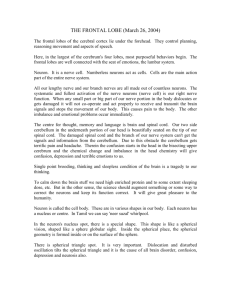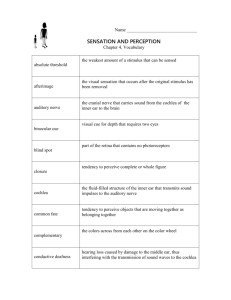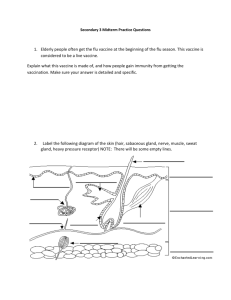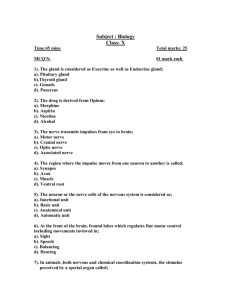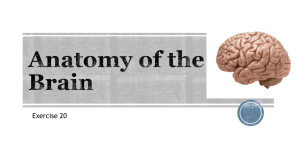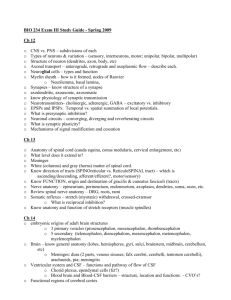Study guide for test 2: Divisions of nervous system, structure of
advertisement
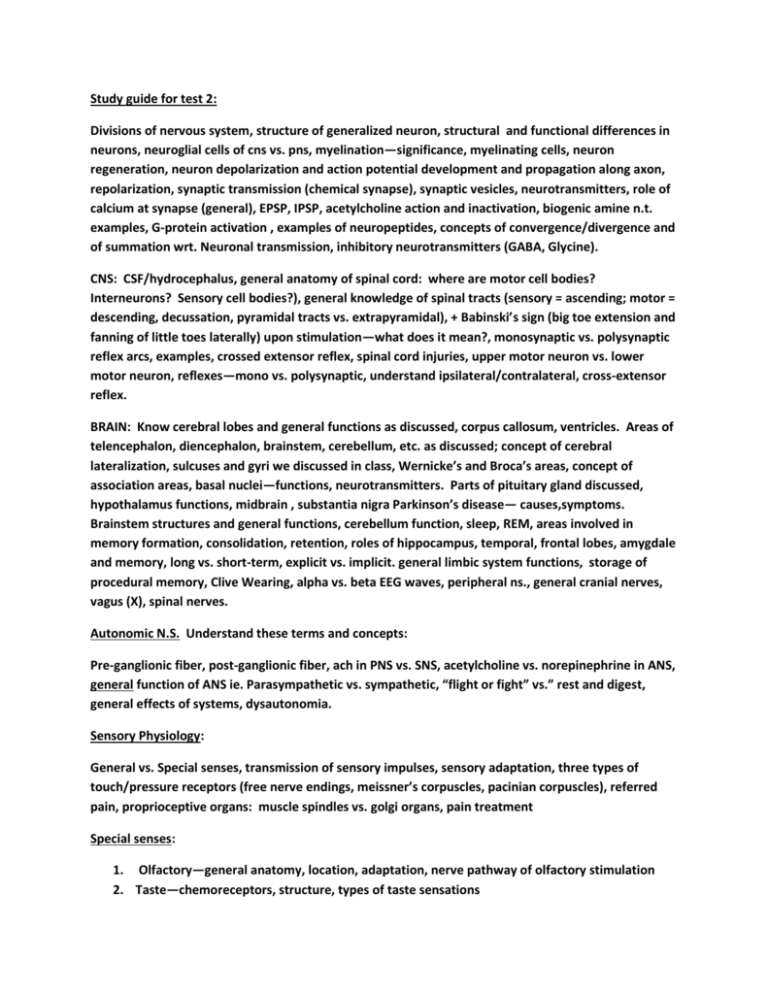
Study guide for test 2: Divisions of nervous system, structure of generalized neuron, structural and functional differences in neurons, neuroglial cells of cns vs. pns, myelination—significance, myelinating cells, neuron regeneration, neuron depolarization and action potential development and propagation along axon, repolarization, synaptic transmission (chemical synapse), synaptic vesicles, neurotransmitters, role of calcium at synapse (general), EPSP, IPSP, acetylcholine action and inactivation, biogenic amine n.t. examples, G-protein activation , examples of neuropeptides, concepts of convergence/divergence and of summation wrt. Neuronal transmission, inhibitory neurotransmitters (GABA, Glycine). CNS: CSF/hydrocephalus, general anatomy of spinal cord: where are motor cell bodies? Interneurons? Sensory cell bodies?), general knowledge of spinal tracts (sensory = ascending; motor = descending, decussation, pyramidal tracts vs. extrapyramidal), + Babinski’s sign (big toe extension and fanning of little toes laterally) upon stimulation—what does it mean?, monosynaptic vs. polysynaptic reflex arcs, examples, crossed extensor reflex, spinal cord injuries, upper motor neuron vs. lower motor neuron, reflexes—mono vs. polysynaptic, understand ipsilateral/contralateral, cross-extensor reflex. BRAIN: Know cerebral lobes and general functions as discussed, corpus callosum, ventricles. Areas of telencephalon, diencephalon, brainstem, cerebellum, etc. as discussed; concept of cerebral lateralization, sulcuses and gyri we discussed in class, Wernicke’s and Broca’s areas, concept of association areas, basal nuclei—functions, neurotransmitters. Parts of pituitary gland discussed, hypothalamus functions, midbrain , substantia nigra Parkinson’s disease— causes,symptoms. Brainstem structures and general functions, cerebellum function, sleep, REM, areas involved in memory formation, consolidation, retention, roles of hippocampus, temporal, frontal lobes, amygdale and memory, long vs. short-term, explicit vs. implicit. general limbic system functions, storage of procedural memory, Clive Wearing, alpha vs. beta EEG waves, peripheral ns., general cranial nerves, vagus (X), spinal nerves. Autonomic N.S. Understand these terms and concepts: Pre-ganglionic fiber, post-ganglionic fiber, ach in PNS vs. SNS, acetylcholine vs. norepinephrine in ANS, general function of ANS ie. Parasympathetic vs. sympathetic, “flight or fight” vs.” rest and digest, general effects of systems, dysautonomia. Sensory Physiology: General vs. Special senses, transmission of sensory impulses, sensory adaptation, three types of touch/pressure receptors (free nerve endings, meissner’s corpuscles, pacinian corpuscles), referred pain, proprioceptive organs: muscle spindles vs. golgi organs, pain treatment Special senses: 1. Olfactory—general anatomy, location, adaptation, nerve pathway of olfactory stimulation 2. Taste—chemoreceptors, structure, types of taste sensations 3. Hearing—parts of the ear (what composes external, middle, inner ear) Know path of sound waves from external auditory meatus to nerve. External—auricle, external auditory meatus, tympanic membrane Middle—auditory ossicles—malleus, incus, stapes,oval window, auditory tube Inner ear: Understand Bony(osseous) labyrinth vs. membranous, perilymph vs. endolymph Cochlear structure, function; a. Scala vestibule, scala tympani, cochlear duct, basilar membrane b. Organ of corti—basilar membrane, receptor cells, tectorial membrane, innervation c. Transmission and detection of sound from external auditory meatus to cochlear nerves to brain d. Hearing loss—causes, general idea of cochlear implant, conductive vs. nerve damage semicircular canals: structure, function:rotational movement (dynamic equilibrium): reception of impulse, ampullae, crista ampularis, hair cells, endolymph role vestibule:utricle, saccule, macula, haircells, otoliths, understand response of macula to head position and linear acceleration 4. Vision: a. Lacrimal gland and route to nose (nasolacrimal duct), structure and functions of cornea, sclera, iris, ciliary muscles, lens, aqueous vs. vitreous humor (where are they), retina, rods and cones , optic chiasma and decussation of nerve tracts from medial eye(maybe bonus question on nerve damage to eye ) b. how accommodation occurs (ie. Contraction of ciliary mm. causes relaxation of ligaments, and lens relaxes; relaxation of ciliary mm. causes tightening of ligaments and flattening of lens), iris dilation and constriction(papillary light response), sympathetic control of PLR and clinical relevance, glaucoma causes (which humor?)and consequences c. Retina, rods vs. cones (functions, ie. Color/day vs. night, pigment of rods=rhodopsin), focus onto retina—lenses used in nearsightedness vs. farsightedness, which is which?, fovea centralis, blindspot, visual pathway from cornea to optic nerve. d. Stereoscopic vision—allows depth perception Age related changes: cataracts, glaucoma, macular degeneration--Hearing loss due to nerve degeneration, damaged organ of corti, or chronic conductive



